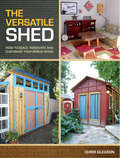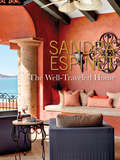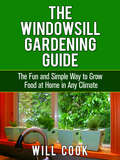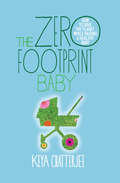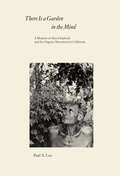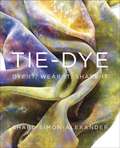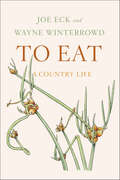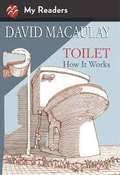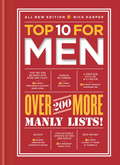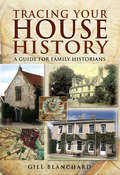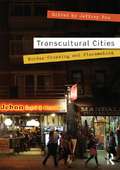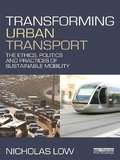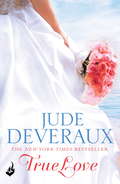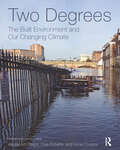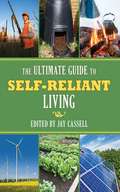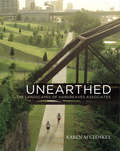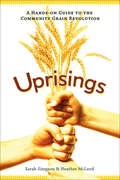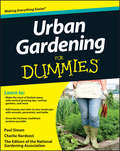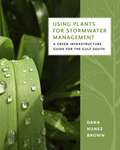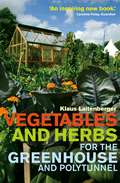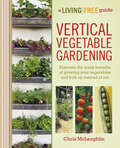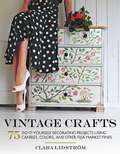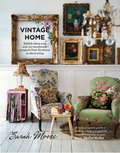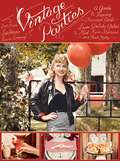- Table View
- List View
The Versatile Shed: How To Build, Renovate and Customize Your Bonus Space
by Chris GleasonSheds aren't just for storage anymore. With a little bit of thought and work, your shed can become a guest cottage, a recording studio, a writer's getaway and even a "small" business location. With more people staying in their current homes, the opportunity to add on beyond the scope of the existing house is more appealing than ever. The Versatile Shed offers basic how-to for building your own shed structure, along with recommendations for electrical and comfort needs. Also included are ideas for working with pre-fabricated sheds, with suggestions for customization. But mostly, this book is about ideas. With dozens of ideas for interior and exterior customization that will add an extra, and versatile, space to your home.
The Well-Traveled Home
by Sandra EspinetLuxury homes with international panache—includes over 175 exquisite photos.Sandra Espinet&’s extensive world travels produce finds of exquisitely wrought artisanal furniture, dramatic artworks, and exotic accessories that are put to beautiful use in interiors. Blending the fabulous objects culled from particular corners of the globe is a delicate art form. Well-known to viewers of HGTV, Espinet is a mix-master of eclectic convergence, a specialist in the fearless melding of exotic elements with traditional furnishings into stylish and unforgettable presentations of comfort and calm, exhilaration and extravagance. This gorgeous book showcases her unique knack for incorporating international treasures into alluring domestic living spaces.
The Windowsill Gardening Guide: The Fun and Simple Way to Grow Food at Home in Any Climate
by Will CookStart growing herbs and other fresh produce at home with this illustrated, step-by-step guide to indoor gardening.You don’t need to live on a farm to grow your own food. With this guide from urban gardening expert Will Cook, you could be just months away from harvesting delicious, fresh organic food from your indoor garden. All you need is a window!In this beginner-friendly guide, Will explains how to grow everything from herbs and leafy greens to tomatoes and even larger plants. From composting basics to re-growing produce from scraps, The Windowsill Gardening Guide provides easy-to-follow instructions and time-tested techniques that don’t require expensive kits, tools, or supplies.
The Zero Footprint Baby
by Keya ChatterjeeIn our culture, pregnancy, birth, and childrearing are deeply connected to consumption and resource use. From the baby shower to the minivan and the larger apartment or first house, the baby-raising years are the most hyper-consumptive of our lives, and can set a family on an unsustainable track for years to come. The Zero Footprint Baby: How to Save the Planet While Raising a Healthy Baby shows how to raise a child with little to no carbon footprint. The book covers every issue new parents face, including pregnancy (what kind of birth has the lowest impact); what to feed your baby (breastfeed, formula, or both?), childcare (who should take care of the baby, and how?), and of course, diapering. Using a mix of personal anecdotes, summarized research, and clear guidance on how to pursue the most sustainable baby-rearing options, The Zero Footprint Baby is the resource and reference book for all new parents with green inclinations. Keya Chatterjee is the director for international climate policy at the World Wildlife Fund. She previously served as a climate change specialist at the US Agency for International Development, and also worked on communicating climate issues while at NASA. Keya's commentary on climate change policy and sustainability issues has been quoted in numerous media outlets, including USA Today, The New York Times, Fox News, The Associated Press, The Washington Post, and NBC Nightly News. She was also featured in a special issue of Politico on climate change highlighting the "muscle of the movement."
There Is a Garden in the Mind
by Paul A. LeeThere Is a Garden in the Mind presents an engaging look at the work and life of pioneering organic gardener Alan Chadwick and his profound influence on the organic farming movement. In this wide-ranging and philosophical memoir, author Paul Lee recounts his first serendipitous meeting with Chadwick in Santa Cruz, California, in 1967, and their subsequent founding of the Chadwick Garden at UC Santa Cruz, the first organic and biointensive garden at a U.S. university. Today, there are few who would dispute the ecological and health benefits of organically produced food, and the student garden project founded by Chadwick and Lee has evolved into a world-renowned research center that helps third-world farmers obtain high yields using organic gardening. But when Chadwick and Lee first broke ground in the 1960s, the term "organic" belonged to the university's chemists, and the Chadwick Garden spurred a heated battle against the whole system of industrial existence. Lee's memoir contextualizes this struggle by examining the centuries-old history of the conflict between industrial science and organic nature, the roots of the modern environmental movement and the slow food movement, and the origin of the term "organic." His account of Chadwick's work fills in a gap in the history of the sustainable agriculture movement and proposes that Chadwick's groundwork continues to bear fruit in today's burgeoning urban garden, locavore, and self-sufficiency movements.Table of contents:Chapter one The English Gardener ArrivesChapter two The English Gardener Goes to WorkChapter three The Garden PlotChapter four Goethe the Vitalist contra Newton the PhysicalistChapter five Urea! I Found It!Chapter six USA and Earth DayChapter seven The MethodChapter eight Chadwick DepartsChapter nine A Moral Equivalent of WarChapter ten The Death of ChadwickChapter eleven California Cuisine and the Homeless Garden ProjectChapter twelve A Biodynamic Garden on Long IslandChapter thirteen Chadwick's LegacyFrom the Trade Paperback edition.cy
Tie-Dye: Dye It, Wear It, Share It
by Shabd Simon-AlexanderTHE MODERN TWIST ON TIE-DYE Tie-dye has grown up and resurfaced as one of today's most inspired looks. Whether dip-dye, shibori, ombré, or the traditional circle pattern, the new take on tie-dye is amazingly fresh, fashionable, and fun. In Tie-Dye: Dye It, Wear It, Share It, acclaimed fashion designer and artist Shabd Simon-Alexander shares her techniques for creating the innovative styles that make her own hand-dyed collection so popular. Packed with Shabd's design secrets, color guidance, expert tips on making each piece distinctly your own, and twenty-two step-by-step projects for garments, accessories, and home décor items, this book will soon have you creating sophisticated dresses, leggings, scarves, tees, and more. Once you experience tie-dye like this, you'll never think of it the same way again!over your floor in newspaper, and get ready to make some color! Once you experience tie-dye like this, you'll never think of it the same way again!
To Eat: A Country Life
by Joe Eck Wayne WinterrowdA memorable book about the path food travels from garden to tableA celebration of life together, a tribute to an utterly unique garden, a wonderfully idiosyncratic guide for cooks and gardeners interested in exploring the possibilities of farm-to-table living—To Eat is all of these things and more. In 1974, Joe Eck and Wayne Winterrowd moved from Boston to southern Vermont, where they became the proprietors of a twenty-eight-acre patch of wilderness. The land was forested, overgrown, and wild, complete with a stream. Today, North Hill's seven carefully cultivated acres—open to visitors during the warmer months—are an internationally renowned garden. In the intervening years, both the garden and the gardening books (A Year at North Hill, Living Seasonally, Our Life in Gardens) Eck and Winterrowd created together have been acclaimed in many forms, including in the pages of The New York Times. They were at work on To Eat—which also includes recipes from the renowned chef and restaurateur Beatrice Tosti di Valminuta and beautiful illustrations from their long-time collaborator Bobbi Angell—when Winterrowd passed away, in 2010. Informative, funny, and moving, the delights within—a runaway bull; a recipe for crisp, fatty chicarrones; a personal history of the Egyptian onion; a hymn to the magic of lettuce—are sure to make To Eat a book readers return to again and again.
Toilet: How It Works (My Readers #3)
by David MacaulayEveryone knows what a toilet is for, right? But what exactly happens after you flush? Where does our waste go, and how is it made safe? With his unique blend of informative text and illustration, David Macaulay takes readers on a tour of the bathroom, plumbing, and the sewer system, from the familiar family toilet to the mysterious municipal water treatment plant.
Top 10 for Men: over 200 more manly lists! (Top 10)
by Nick HarperYou're a man. You love facts. Facts amuse you. The more trivial the better.The most important things in the world - sport, cars, gadgets, beer, meat - come together in this unbeatable collection of lists to feed your manly desire for knowledge and trivia. Discover vital facts and stats on the world's fastest cars, deadliest weapons, shortest football players and strongest drinks, and then wow everyone you know with your findings.
Tracing Your House History: A Guide For Family Historians (Tracing Your Ancestors)
by Gill Blanchard“With its practical slant and focus on demystifying unfamiliar property documents, this is the perfect introduction to tracing a house history.” —Family Tree MagazineAnyone who wants to find out about the history of their house—of their home—needs to read this compact, practical handbook. Whether you live in a manor house or on a planned estate, in a laborer’s cottage, a tied house, a Victorian terrace, a twentieth-century council house or a converted warehouse—this is the book for you. In a series of concise, information-filled chapters, Gill Blanchard shows you how to trace the history of your house or flat, how to gain an insight into the lives of the people who lived in it before you, and how to fit it into the wider history of your neighborhood.A wealth of historical evidence is available in libraries, archives and record offices, in books and online, and this is the ideal introduction to it. Gill Blanchard explores these resources in depth, explains their significance and directs the researcher to the most relevant, and revealing, aspects of them. She makes the research process understandable, accessible and fun, and in the process, she demystifies the sometimes-obscure language and layout of the documents that researchers will come up against.“This book is more than a guide to researching the history of your house, or a house of interest. It is a font of interest if you are seeking to research and understand the social and domestic lives of people and their communities from early times.” —Federation of Family History Societies
Transcultural Cities: Border-Crossing and Placemaking
by Jeffrey HouTranscultural Cities uses a framework of transcultural placemaking, cross-disciplinary inquiry and transnational focus to examine a collection of case studies around the world, presented by a multidisciplinary group of scholars and activists in architecture, urban planning, urban studies, art, environmental psychology, geography, political science, and social work. The book addresses the intercultural exchanges as well as the cultural trans-formation that takes place in urban spaces. In doing so, it views cultures not in isolation from each other in today’s diverse urban environments, but as mutually influenced, constituted and transformed. In cities and regions around the globe, migrations of people have continued to shape the makeup and making of neighborhoods, districts, and communities. For instance, in North America, new immigrants have revitalized many of the decaying urban landscapes, creating renewed cultural ambiance and economic networks that transcend borders. In Richmond, BC Canada, an Asian night market has become a major cultural event that draws visitors throughout the region and across the US and Canadian border. Across the Pacific, foreign domestic workers in Hong Kong transform the deserted office district in Central on weekends into a carnivalesque site. While contributing to the multicultural vibes in cities, migration and movements have also resulted in tensions, competition, and clashes of cultures between different ethnic communities, old-timers, newcomers, employees and employers, individuals and institutions. In Transcultural Cities Jeffrey Hou and a cross-disciplinary team of authors argue for a more critical and open approach that sees today’s cities, urban places, and placemaking as vehicles for cross-cultural understanding.
Transforming Urban Transport: From Automobility to Sustainable Transport
by Nicholas LowTransforming Urban Transport confronts head-on the dilemma faced by a world wedded to mobility: the danger of continuing along the fossil-fuelled path and the real paucity of viable technological alternatives which can be deployed in time. To respond to the dilemma, the ideal of urban transport must be changed from auto-based mobility to systems of sustainable transport in which public transport, and non-motorised transport work together to reduce climate change pressures, enhance urban quality and preserve life and health. The book challenges the commonly held view that a combination of urbanity and higher residential density expressed in compact cities (expected to have greater public transport use) will resolve urban transport/environment problems, instead showing that transport systems can be changed to meet the environmental imperatives without the massive spatial change implied. But the problem of change of urban transport is profoundly institutional and cultural. Changes in urban mobility and transport require local institutional policy action. To support such action, the book explores new methods of governance of transport in dispersed and concentrated cities, new techniques for assessing transport need, ways of improving childhood mobility, guidelines for political mobilization, and norms of knowledge sharing. Drawing together leading scholars from different disciplines in Australia, Japan and China, this book provides a unique fusion of Asian and Australasian perspectives and engages with the coming needs of transport planning practitioners in both high density and dispersed cities.
True Love: Nantucket Brides Book 1 (Nantucket Brides)
by Jude DeverauxEscape to glorious Nantucket in this truly enchanting summer read... True Love begins New York Times bestselling author Jude Deveraux's breathtaking Nantucket Brides trilogy, introducing characters from a new generation of Montgomery-Taggerts, the beloved family from her classic novels.Just as Alix Madsen is finishing up architectural school, Adelaide Kingsley dies and wills her, for one year, the use of a charming nineteenth-century Nantucket house. Alix accepts the quirky bequest, in part because it gives her time to plan her best friend's storybook wedding.But it seems that Adelaide Kingsley had a rather specific task for Alix: to solve the strange disappearance of one of the Kingsley women, Valentina, more than two hundred years ago. If that wasn't troubling enough, Alix must deal with the arrogant (and extremely good-looking) architect Jared Montgomery, who is living in the property's guesthouse and who harbours secrets of his own.As sparks fly, the ghosts of the past begin to reveal themselves. Finding their lives inextricably entwined with the turbulent fortunes of their ancestors, Alix and Jared discover that only by righting the wrongs of the past can they hope to be together.Jude Deveraux. Love stories to enchant you.Look for the next in gorgeous stories in the Nantucket Brides series, For All Time and Ever After.
Two Degrees: The Built Environment And Our Changing Climate
by Alisdair McGregor Cole Roberts Fiona CousinsThe Earth’s temperature has been rising. To limit catastrophic outcomes, the international scientific community has set a challenging goal of no more than two degrees Celsius (3.6 degrees Fahrenheit) average temperature rise. Economists agree we will save trillions of dollars by acting early. But how do we act successfully? And what’s the backup plan if we fall short? Setting politics aside, Two Degrees reviews the current science and explains how we can set practical steps to reduce the extent of warming and to adapt to the inevitable changes, all while improving the bottom line, beautifying our communities, and increasing human health. The book is a practical guide intended for a broad audience of those who occupy and shape our built environment. The authors provide a clear framework for communities, policy makers, planners, designers, developers, builders, and operators to help manage the impacts and capture the opportunities of our changing climate. Two Degrees is divided into three sections—Fundamentals, Mitigation, and Adaptation—covering a diverse array of topics ranging from climate-positive communities and low-carbon buildings to the psychology of choice and the cost of a low-carbon economy. After a foreword by Amory Lovins, more than 10 contributing authors share knowledge based on direct experience in all aspects of built environment practice. This book clarifies the misconceptions, provides new and unique insights, and shows how a better approach to the built environment can increase resilience and positively shape our future.
Ultimate Guide to Self-Reliant Living, The
by Jay CassellBeing a homesteader today may seem difficult; the world is full of so many gadgets and conveniences, many of which most of us consider necessary to live a full and happy life. In this collection, edited and arranged by Jay Cassell, you'll see that going off the grid, adapting to your surroundings, and depending on yourself and your land is really not as challenging as one may think. With the information and tips you learn in this book, you'll easily find success as a modern-day homesteader.The essays featured in The Ultimate Guide to Self-Reliant Living were written by some of today's most respected outdoorsmen and outdoorswomen, nature enthusiasts, agricultural professionals, and successful homesteaders. Through the information on these pages, you will learn the best techniques and approaches concerning:Hunting, fishing, and trappingForagingGrowing and preparing your own foodAnimal husbandryLiving off the gridBuilding barns and outbuildingsGreen livingCountry skillsAlternative energy, such as solar panels and windmillsPrimitive survival skills, such as making fires and finding shelter
Unearthed: The Landscapes of Hargreaves Associates (Penn Studies in Landscape Architecture)
by Karen M'CloskeyThe work of landscape architecture firm Hargreaves Associates is globally renowned, from the 21st Century Waterfront in Chattanooga, Tennessee, to London's 2012 Olympic Park. Founded by George Hargreaves in 1983, this team of designers has transformed numerous abandoned sites into topographically and functionally diverse landscapes. Hargreaves Associates' body of work reflects the socioeconomic and legislative changes that have impacted landscape architecture over the past three decades, particularly the availability of former industrial sites and their subsequent redevelopment into parks. The firm's longstanding interest in such projects brings it into frequent contact with the communities and local authorities who use and live in these built environments, which tend to be contested grounds owing to the conflicting claims of the populations and municipalities that use and manage them. As microcosms of contemporary political, social, and economic terrains, these designed spaces signify larger issues in urban redevelopment and landscape design.The first scholarly examination of the firm's philosophy and body of work, Unearthed uses Hargreaves Associates' portfolio to illustrate the key challenges and opportunities of designing today's public spaces. Illustrated with more than one hundred and fifty color and black-and-white images, this study explores the methods behind canonical Hargreaves Associates sites, such as San Francisco's Crissy Field, Sydney Olympic Park, and the Louisville Waterfront Park. M'Closkey outlines how Hargreaves and his longtime associate Mary Margaret Jones approach the design of public places—conceptually, materially, and formally—on sites that require significant remaking in order to support a greater range of ecological and social needs.
Uprisings: A Hands-On Guide to the Community Grain Revolution
by Sarah Simpson Heather McLeodThis practical guide explores the food security and community sufficiency benefits of growing local grain—and shows you how easy it is to get started.If we want to reduce our environmental impact, build resiliency in our community, and improve food security, it's up to us to make it happen. Uprisings shows how communities across North America can take action by reviving local grain production.Environmental journalist Sarah Simpson profiles of ten unique community models demonstrating how local grain production is already making a difference. She then shares step-by-step instructions for small-scale grain production that will turn any community into a hotbed of revolution. Learn about:How locally grown wheat, barley, and other grains can impact a communityHow to start a community grain project from scratchHow to plant, grow, harvest, thresh, winnow, and store your grainHow to use whole and sprouted grains in your kitchen
Urban Gardening For Dummies
by Paul Simon The National Gardening Association Charlie NardozziThe easy way to succeed at urban gardeningA townhouse yard, a balcony, a fire escape, a south-facing window--even a basement apartment can all be suitable locations to grow enough food to save a considerable amount of money and enjoy the freshest, healthiest produce possible.Urban Gardening For Dummies helps you make the most of limited space through the use of proven small-space gardening techniques that allow gardeners to maximize yield while minimizing space.Covers square-foot gardening and vertical and layered gardeningIncludes guidance on working with container gardening, succession gardening, and companion gardeningOffers guidance on pest management, irrigation and rain barrels, and small-space compostingIf you're interested in starting an urban garden that makes maximum use of minimal space, Urban Gardening For Dummies has you covered.
Using Plants for Stormwater Management: A Green Infrastructure Guide for the Gulf South
by Dana Nunez BrownThe subtropical climate of the Gulf South supports a varied abundance of flora, and this diversity is sustained by the ample amount of rainwater that characterizes the region. Managing rainwater in a planned environment and mitigating its effect on human habitation can test the skills of even the most seasoned landscape architect or designer. That challenge has never been more acute as increased human demand for natural resources compels professionals and home gardeners alike to seek out sustainable ecological solutions.In this guidebook, Dana Nunez Brown details ways to manage each drop of rainwater where it falls, using a cost-effective and environmentally sensitive approach. Under natural conditions, rainfall primarily percolates into the ground and flows as groundwater until it is absorbed by trees and other vegetation, after which it is evaporated into the atmosphere and the cycle starts anew. Brown identifies plants and techniques that leverage this natural process in order to filter, clean, and slow runoff, a practice known as Low Impact Development. Using Plants for Stormwater Management presents the native ecological communities and plant species of the Gulf South in easy-to-follow sections and diagrams. Information ranging from the productiveness of root structures and the compatibility of plants with local soils to the optimal elevation of specific vegetation and the average dimensions of foliage is represented by graphic icons for quick and easy identification. An accessible and essential resource, this book gives both novices and experts the know-how to harness rainfall and create beautiful, ecologically functioning landscapes.
Vegetables and Herbs for the Greenhouse and Polytunnel
by Klaus LaitenbergerWith our unpredictable weather, there's never been a better time to cultivate vegetables under shelter. Experienced grower, Klaus Laitenberger shows how to use the heat and shelter of a greenhouse or polytunnel to maximise crop production and supply tasty, healthy food throughout the year. He gives full details of sowing, planting, spacing and harvesting for all our best-loved herbs and vegetables, as well as introducing exotic newcomers such as pepino and yacon.
Vegetables and Herbs for the Greenhouse and Polytunnel
by Klaus LaitenbergerWith our unpredictable weather, there's never been a better time to cultivate vegetables under shelter. Experienced grower, Klaus Laitenberger shows how to use the heat and shelter of a greenhouse or polytunnel to maximise crop production and supply tasty, healthy food throughout the year. He gives full details of sowing, planting, spacing and harvesting for all our best-loved herbs and vegetables, as well as introducing exotic newcomers such as pepino and yacon.
Vertical Vegetable Gardening: Discover the Many Benefits of Growing Your Vegetables and Fruit Up Instead of Ou (A Living Free Guide)
by Chris McLaughlinGrow up, not out! Are you a gardener (or aspiring gardener) who is short on space? Vertical methods and structures for growing plants are an ideal way to maximize your real estate, and they're eye-catching, too.Vertical solutions deliver more yield in fewer square feet, especially perfect for the urban gardener. They're less work, too, so you can forget all-day weeding and watering. Some vegetables, such as tomatoes and pole beans, have been grown vertically for a very long time, but those who need to maximize space can grow almost any type of plant vertically—from melons and squash to carrots, peppers, and pears.Vertical growing isn't just practical, it's beautiful, too! Trellises, terra cotta towers, and hanging planters (to name a few!) transform an outdoor space into a magical garden.Vertical Vegetable Gardening is your thorough guide for growing all types of leafy, root, and other vegetables vertically. Included in the book are: • Creative ideas for structures and containers that will save you space, including DIY projects and repurposing suggestions • Profiles on dozens of plant varieties, including planting, tending, and harvesting instructions • How to make your own garden bed • Soil, seed, and gardening basics • Pest control guidance
Vintage Crafts: 75 Do-It-Yourself Decorating Projects Using Candles, Colors, and Other Flea Market Finds
by Clara LidströmVintage flair isn't just classy and cute; it's fun to create and perfect for any budget! So let your creativity run wild on trips to the flea market, and don't back down from that deal at the yard sale. With Vintage Crafts, use paper scraps, teacups, and a splash of paint to decorate your house room by room.More than just a craft book, Vintage Crafts features recipes fresh from the countryside, lessons for safe and easy outdoor improvement, and tips for keeping your house eco-friendly. This is the ultimate home decor resource from Sweden's number one lifestyle blogger, Clara Lidström. Learn to liven up secondhand clothes, turn old fabrics into patchwork projects, and interject some '50s-era chic into your thrift store finds.Elegant, old-style country projects include:Champagne box bookshelvesWallpapering with mapsSilhouette framesBaby shoe flower plantersBark and twig lanternsAnd so much more to make with your two hands and flea market bargains!So look around: if your house is full of scraps and never-used knickknacks, turn them into something beautiful, useful, and made by you! With Vintage Crafts at your crafting table, your hands will never be idle again!
Vintage Home: Stylish Ideas And Over 50 Handmade Projects From Furniture To Decorating
by Sarah MooreRecycle, revamp and rejuvenate; with over 50 projects Sarah covers a whole spectrum of imaginative ideas for every room of the house, from blanket curtains to patchwork wallpaper, clever storage crates to fun mobiles for children, as well as unique ideas for dining, sleeping and bathing. Interweaved throughout the book are ideas for 'one thing four ways' to show how the same piece of furniture or a room can be updated with different look, plus handy advice on essential kit and techniques. Aimed at all skill levels, the projects can be completed in a few hours or over a weekend so you can revamp and refurbish your home in no time at all.
Vintage Parties: A Guide to Throwing Themed Events?from Gatsby Galas to Mad Men Martinis and Much More
by Linda Hansson Louise Lemming Emma SundhInvite your nearest and dearest for a celebration¬-vintage style! Vintage bloggers Linda Hansson, Louise Lemming, and Emma Sundh reveal their secrets for throw the best parties, festivities, and fetes with a nostalgic twist. With this beautiful reference for hosting themed get-togethers, you'll create the right old-time atmostphere, play classic games, serve treats and cuisine with yesterday's pomp and flair, and best of all-you'll look the part! Get creative with: Pompoms and balloons for a spring fling "Air-mail" place settings for a '40s theme Nautical cushions, placemats, and decor '50s photobooth props and parlor games Typewriter guestbooks for a Gatsby effect And so much more to create your perfect retro look!Add to that make-up and hairstyles from yesteryear, tips on how to care for a vintage dress, and how to sew the perfect skirt or a festive bow tie. Plus, discover great recipes for modern updates on such time-honored offerings as homemade donuts, apple pie moonshine, cake pops, picnic sandwiches, and, of course, champagne.Packed to the brim with clever do-it-yourself creations from vintage and thrift store finds, Vintage Party is the retro-crafter's dream guide for throwing parties everyone will RSVP yes to. So toast with pastel lemonade-welcome to your vintage party!
